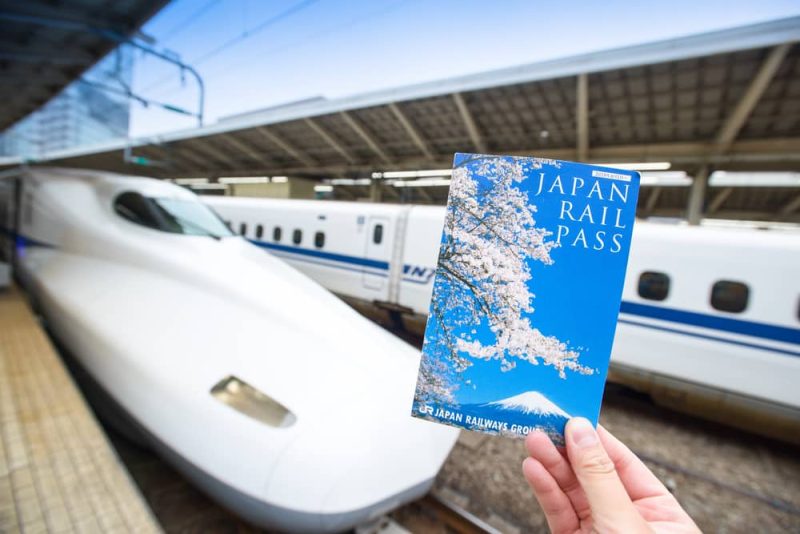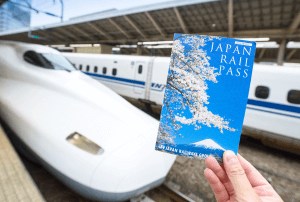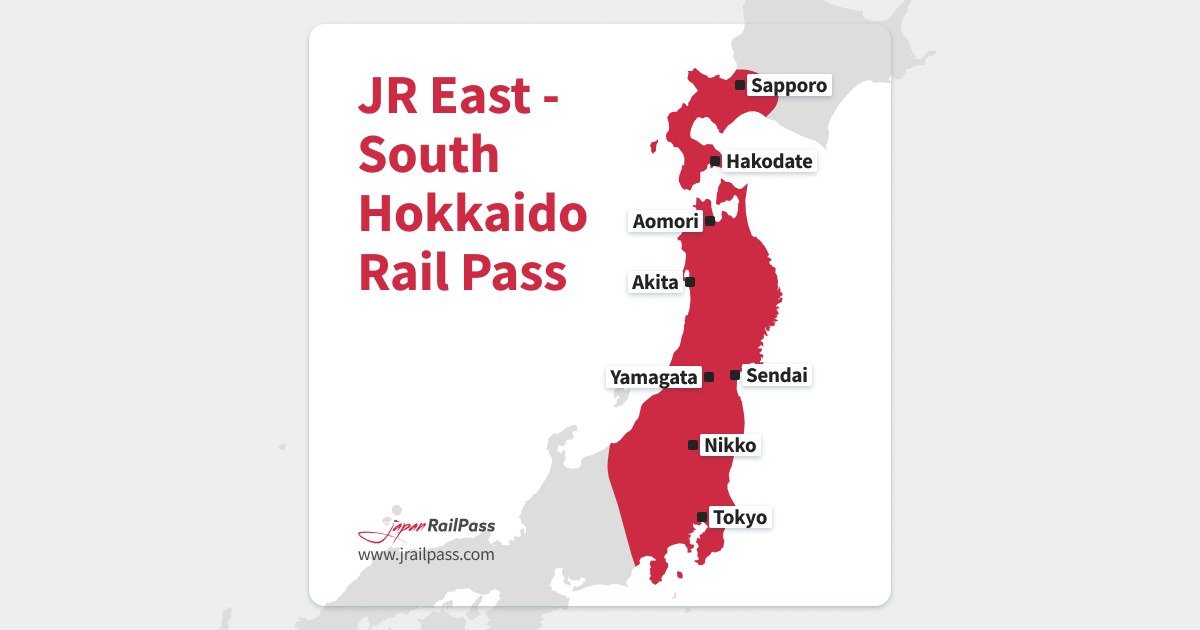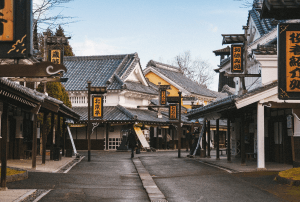Planning a trip around Tohoku, Kanto, and Hokkaido? The region includes many of the country’s top destinations, including Tokyo, Nikko, and Fukushima, which are easily accessible by train.
To get the most out of your budget and time in Japan, it’s important to choose the right rail pass. Two popular choices for visitors in this region are the all-inclusive national JR Pass and the JR East-South Hokkaido Rail Pass.
The best ticket for your trip depends on your itinerary, budget, and travel plans. In this post, we’ll compare both in terms of coverage, validity, and cost, so you can make the right choice between the regional and national JR Pass.
Table of Contents
JR Pass vs. JR Regional Pass coverage
The key difference between the JR East-South Hokkaido Rail Pass and the JR Pass is the coverage across Japan’s rail networks.
Both tickets give you access to high-speed bullet trains, but not all lines are included when you buy a regional pass. Here’s a look at the key differences in access:
JR Pass

- Nationwide access across Japan
- No limit to the number of journeys you take
- Covers all major cities: Tokyo, Osaka, Kyoto, Hiroshima
- Includes all Shinkansen lines
- Covers all types of JR trains, and some buses and ferries


Unlimited access to transportation across Japan for 7, 14, or 21 days on:
- All Shinkansen trains
- Rapid and Local JR trains
- JR bus and ferry services
- Airport Transfers
A single ticket, huge savings.
JR East-South Hokkaido Rail Pass

- Access to JR trains in East Japan and South Hokkaido
- No limit to the number of journeys you take
- Covers major stops in the area: Tokyo, Sendai, Morioka, Hakodate
- Includes some regional Shinkansen lines
- Excludes western cities like Osaka, Kyoto, Hiroshima


Unlimited 6-day access to JR East services within the Kanto, Tohoku, and southern Hokkaido regions, including use of Shinkansen and Joyful trains.
The national JR Pass allows you to explore the entire country, with no regional restrictions.
However, if you’re planning on staying in the areas of Tohoku, Kanto, and Hokkaido, the East-South Hokkaido Pass is a more cost-effective option. You can find details on which Shinkansen lines are covered in the table below.
Which Shinkansen lines are included?
Both the JR Pass and JR East-South Hokkaido Rail Pass include access to Japan’s famous bullet trains, but there are some important differences in coverage:
| Shinkansen Line |
JR Pass |
JR East-South Hokkaido Pass |
|---|---|---|
| Akita Shinkansen |
✔️ |
✔️ |
| Hokkaido Shinkansen |
✔️ |
✔️ |
| Hokuriku Shinkansen |
✔️ |
✔️ (Tokyo to Sakudaira only) |
| Joetsu Shinkansen |
✔️ |
✔️ |
| Kyushu Shinkansen |
✔️ |
❌ |
| Sanyo Shinkansen |
✔️ |
❌ |
| Tokaido Shinkanson |
✔️ |
❌ |
| Tohoku Shinkansen |
✔️ |
✔️ |
| Yamagata Shinkansen |
✔️ |
✔️ |
The JR East-South Hokkaido Rail Pass covers the major high-speed lines in northern Japan. If you’re sticking to this region, you’ll get unlimited access.
To add destinations in western Japan to your trip, like Osaka, Kyoto, Hiroshima, or Kyushuor, the national pass is the only option.
Pass validity: How long does each pass last?
You can get a 7, 14, or 21 day national JR Pass, all of which cover a consecutive period. It’s ideal for longer trips, especially if you plan to use the rail network to visit many areas of the country.
The JR Pass is especially useful if you prefer to keep your travel itinerary open. It gives you total flexibility, and covers all Shinkansen lines in Japan, so you can plan your route as you go and explore more of the country.
The JR East-South Hokkaido Pass is valid for 6 consecutive days. It’s perfect for shorter trips and allows you to make the most of your time.
You can also use the pass to explore the wider region, and then end your trip with a few days in a big city like Tokyo, where you can use local transport tickets to make your way around the city.
Cost comparison of national and regional JR passes
Whichever type of pass you choose, you’ll save money compared to buying individual tickets if your itinerary includes a number of rail journeys.
Here’s how the cost compares for national JR Passes and the regional pass for JR East-South Hokkaido:
| Pass Type |
Price |
Validity |
Cost per Day |
Area Coverage |
|---|---|---|---|---|
| National JR Pass 7 Days |
¥50,000 |
7 days | ¥7,143 |
Nationwide |
| National JR Pass 14 Days |
¥80,000 |
14 days | ¥5,714 |
Nationwide |
| National JR Pass 21 Days |
¥100,000 |
21 days | ¥4,762 |
Nationwide |
| JR East-South Hokkaido Rail Pass |
¥35,370 |
6 days | ¥5,895 |
North Japan and Hokkaido |
It might be more cost-effective to combine local tickets with a regional pass if you’re planning to only visit North Japan and Hokkaido, but want to stay for more than 6 days.
However, for more extensive trips across Japan, the national JR Pass offers the best savings.
Airport transfers: National vs. JR regional pass
If you’re flying into Tokyo, the Narita Express and Haneda Service airport transfer lines are covered in both the national and regional pass for East-South Hokkaido.
| Airport |
JR Pass |
JR East-South Hokkaido Pass |
|---|---|---|
| Narita International Airport
Around 40 miles from central Tokyo |
✔️ |
✔️ |
| Haneda Airport
Around 10 miles from central Tokyo |
✔️ |
✔️ |
| Kansai International Airport
Around 30 miles from central Osaka |
✔️ |
❌ |
| Itami Airport
Around 5 miles from central Osaka |
❌ |
❌ |
If you’re flying in to Osaka, you’ll need another ticket unless you buy the national JR Pass. The Haruka Express transfers you from Kansai International Airport to Osaka, Kyoto, Nara, and Kobe.
For Itami, you need to take the Osaka Monorail, which is not covered by any type of JR Pass.
Should I get a JR Pass or JR East-South Hokkaido Pass?
The right rail pass for your trip depends on where you’ll travel and how long your trip is.
Both the national JR Pass and the JR East-South Hokkaido Pass cover the Kanto, Tohoku, and southern Hokkaido regions. If you’re only traveling within this area, the regional pass offers significant savings.
It’s best to choose the national JR Pass if you plan to travel to other regions, or if you want more days of unlimited travel.
Check the table earlier on in this post to get a direct cost comparison per day. If your trip lasts less than a week, the regional pass is usually cheaper. For longer trips or flexibility to go further, the JR Pass becomes more cost-effective.
Our site has hundreds of itineraries and useful guides on using your JR Pass to help you get the most out of your time in Japan. Check out all the information, and find the right Japan Rail Pass for your trip.

